
ILO Viet Nam, in collaboration with VITAS, takes another step forward in advancing digital skills in Viet Nam’s textile and garment sector, with CLO Virtual Fashion Company joining this initiative.
Ho Chi Minh CITY, Viet Nam (ILO News) – From 18 to 21 March 2025, the International Labour Organization (ILO), in collaboration with the Viet Nam Textile and Garment Association (VITAS) and CLO Virtual Fashion Company, organized the ToT on basic digital design using CLO and CLOSET 3D design software. Building on the success of the first session in Hanoi in August 2024, this initiative continues to push the boundaries of digital skills enhancement in the textile and garment industry. It also contributes to future waste reduction, aligning with the industry’s green vision.
The training brought together 19 lecturers and teachers from 10 universities and vocational education and training institutions across southern Viet Nam. Participants gained hands-on experience with CLO and CLO-SET software, which streamlines 3D clothing design collaboration from samples to production. The course covered a wide range of topics, including software fundamentals, fabric physics, garment shaping, avatar editing, rendering, and digital collaboration. Participants also explored CLO’s file-sharing and communication platform, enhancing efficiency in digital fashion design. By applying these digital tools in their teaching, they are expected to equip students and learners across the sector with industry-relevant competencies, fostering a more skilled workforce and contributing to the sector’s ongoing transformation.
Positive feedbacks from participants and industry representatives
Nguyen Thi Tram Anh, Head of Branding and Fashion Management, Faculty of Arts & Design at Van Lang University, highlighted the course’s relevance: "The training course is very useful for lecturers like me. With the growing demand for digital design skills in the industry, learning to work with different 3D design software is essential. This course gave us hands-on experience in applying these tools to practical technical training for students at the basic level. I look forward to attending advanced courses to further develop my expertise in digital design.” Van Lang University also demonstrated its strong support for this initiative by providing the training venue, and adequate computers for the training.
Other participants also emphasized the practical impact of the training. Truong Thi Nhat Le, Lecturer of SONADEZI College of Technology and Management, praised the software’s flexibility and real-world applications: "It enhances visualization, saves modelling time, and improves training quality. I can apply it to project presentations and fashion design."
Recognizing the significance of this training, Truong Van Cam, Vice President and Secretary General of VITAS, underscored its role in the sector’s transition: "I greatly appreciate the support from the ILO and value the collaboration between the parties in providing such practical and useful training for teachers and trainers. This initiative will contribute to our efforts in addressing the skills mismatch in the sector, as highlighted in the recent joint ILO-VITAS publication."
Challenges remain
While the software has great potential, learners need time to familiarize themselves with its interface and functions. Regular practice is essential for effective guidance. Some features, like rendering, require high computer configurations that may be beyond the reach of students or institutions. Therefore, collaboration among training institutions, enterprises, and industry stakeholders is crucial to push this initiative forward, giving teachers and students the chance to explore and master new digital skills, paving the way for a more skilled and innovative workforce.
Collaboration for transformation
The successful completion of this second ToT reaffirms the commitment of the ILO under its project[1], VITAS, and CLO Virtual Fashion to advancing digital skills in the textile and garment sector. By equipping educators and training providers with cutting-edge knowledge and skills, this initiative contributes to enhancing education quality and prepares a skilled workforce for the industry’s evolving needs. Moreover, it aligns with broader efforts of the ILO and the country to promote STEM education for women, empowering female educators and students with digital competencies.
To fully harness the potential of digital design technology in education and training, continued collaboration and further training will be essential. Ensuring the sustainability of these efforts will be key to fostering innovation, improving workforce readiness, and driving long-term growth in Viet Nam’s textile and garment sector.
[1] “Future of Work in Textile and Clothing: Forecasting and Developing Skills in Viet Nam to Advance Decent Work and Productivity in the Sector” funded by the Governments of the Netherlands and Japan.



